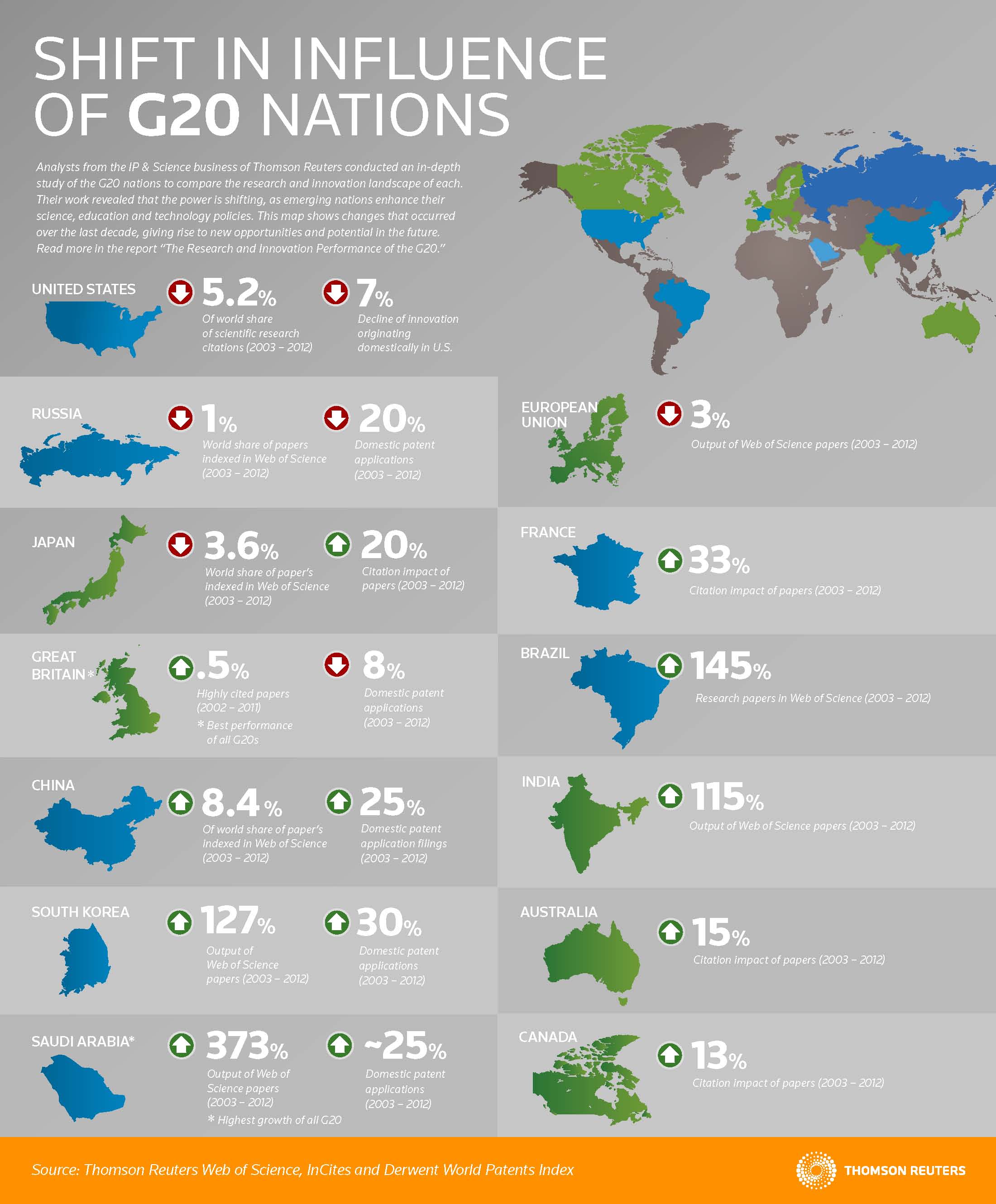 Analysis of G20 nations highlights shifts in emphasis
Analysis of G20 nations highlights shifts in emphasis
PHILADELPHIA, April 9, 2014 – The Intellectual Property & Science business of Thomson Reuters, the world leader in providing intelligent information to businesses and professionals, today releasedThe Research and Innovation Performance of the G20, a report that mines scientific research and patent information across the G20 for insights into the global strategies of the world’s leading economies.
The study, which analyzed citation patterns in scientific research papers and the patent portfolios of the G20 over a ten-year-period, found that emerging markets, notably China and India, have made strides in closing the research and innovation gap with developed nations. The research also finds that while both emerging and developed nations have dramatically expanded the world’s total research capacity over the last decade, the US and EU have begun to lose ground in total world share of new research. The US has also begun to show declines in total global influence of its research.
“As the dynamics of scientific research and innovation evolve around the world, the future picture of the global economy comes into focus,” said Basil Moftah, president, Thomson Reuters IP & Science. “Thomson Reuters is uniquely poised, given our vast content, analytic tools and internal intellectual capital, to uncover such insights and provide valuable perspectives to governments, corporations and institutions around the world.”
Following are some of the key findings:
- Leaders’ Landscape Shifts: The one-time giants of global research and innovation have begun to lose ground. The world share of scientific research citations from the US has fallen from 33 percent in 2003 to 27.8 percent in 2012, while the EU has declined 3 percent over the same period. Additionally, while domestic patent volume has grown steadily from 2003 to 2012 in the US and Europe by annual rates of 2 percent and 1.4 percent respectively, the Chinese rate of growth dwarfs those figuresat 29 percent. Also of note, American innovation accounts for 56 percent of all US patent applications, down from 63 percent in 2003, and seven of the top ten patenting companies in the US have headquarters in Asia.
- Peer-Reviewed Papers Spike in China and India: Chinese peer-reviewed papers accounted for 14 percent of the world’s share in 2012, up from: 5.6 percent in 2002and< 0.5 percent at the start of the 1980s. India produced twice as many published research papers in 2012 as it did in 2003, but the country did experience its first year-over-year dip in 10 years from 2011 to 2012.
- Australia, France and Great Britain Show Strongest Gains in Scientific Influence among Developed Nations: Senior research producers, such as Australia, France and Great Britain, recorded significantly higher rates in their production of highly cited research papers between 2002 and 2011, while the US was the only major developed nation to lose ground over the same period by this measure.
- Physical Science and Chemistry Drive Chinese Innovation: Central to China’s surge in scientific output has been the country’s increased focus in physical sciences – particularly materials science, chemistry and physics. In these fields, along with engineering, mathematics, and geosciences, China recorded its largest shares of the world’s highly cited papers in the period between 2002 and 2011. China also increased its invention patent applications from 40,000 in 2003 to over 400,000 in 2012, partly dueto the government’sconcentration on domestic innovation. Forty-five percent of the world’s natural products and 43 percent of its engineering inventions come from China, whereas just 5.25 percent of the globe’s digital computer inventions originate there.
- India’s Research Citation Influence Lags Output, Patents Volumes Remain Volatile:Over the last ten years, India has increased its production of scientific research by some 146 percent and now accounts for 3.6 percent of the total world share of research production. However, the country’s contribution of highly cited papers as a percentage of total output has remained comparatively low. Patent activity in the region has oscillated between 4,000 and 7,000 patents per year since data became widely available in 2005, but two thirds of all Indian patent applications are from foreign concerns seeking protection for their inventionsin India.
“This study is further proof of the globalization of science and innovation; it is not just a trend, the movement is here to stay,” said Gordon Macomber, managing director for Thomson Reuters Scientific and Scholarly Research. “It also demonstrates the role scientific research and innovation play within the global economy.”
“Within the G20 nations, there is a strong correlation between research activity and economic output,” said David Brown, managing directorfor Thomson Reuters IP Solutions. “Scientific research leads to patents, and although the patent review process can stretch up to seven years, both activities are used over the long term as proxies for innovation.”
The full report,Research and Innovation Performance of the G20, provides detailed snapshots of research citation and patent filing metrics for each G20 nation, along with a detailed commentary on key trends shaping the research and innovation agenda in each region. Data for this report were compiled using Thomson Reuters Web of ScienceTM, InCitesTMand Derwent World Patents Index®.
About Thomson Reuters
Thomson Reuters is the world’s leading source of intelligent information for businesses and professionals. We combine industry expertise with innovative technology to deliver critical information to leading decision makers in the financial and risk, legal, tax and accounting, intellectual property and science and media markets, powered by the world’s most trusted news organization. With headquarters in New York and major operations in London and Eagan, Minnesota, Thomson Reuters employs approximately 60,000 people and operates in over 100 countries. For more information, go to www.thomsonreuters.com

